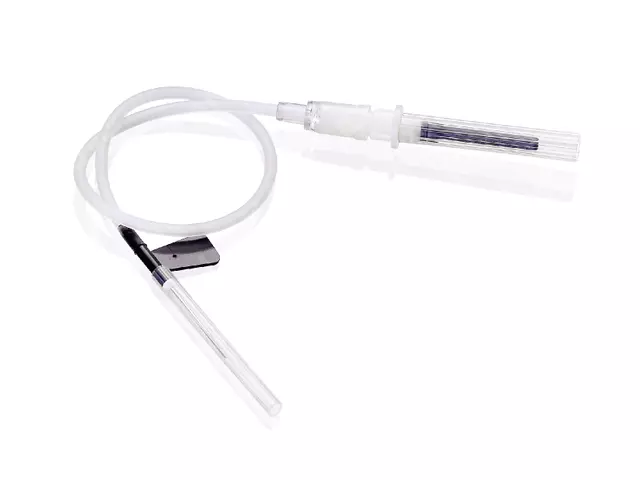Venous Blood Collection Needle: A Key Medical Tool for Accurate Blood Collection
In modern medicine, blood testing is one of the most common diagnostic and monitoring methods. Venous blood collection has become a fundamental step in various medical procedures, and the venous blood collection needle is the core tool in the entire process. Although small in size, its design, materials, operation methods, and application areas are crucial to the success of the blood collection process. This article Kangjian will provide a detailed introduction to the structural design and usage of the venous blood collection needle.

Structure of the Venous Blood Collection Needle
The design of the venous blood collection needle undergoes rigorous scientific evaluation to ensure safety, accuracy, and comfort during blood collection. Each component plays a critical role in achieving these goals.
1. Needle
The most important part of the venous blood collection needle is the needle itself. It is typically made of high-quality stainless steel, which offers excellent corrosion resistance and biocompatibility, ensuring it does not cause allergic reactions or irritation. Additionally, stainless steel has high strength, making the needle resistant to bending or breaking during puncture.
The needle's design is crucial. Modern venous blood collection needles often utilize three-sided sharpening technology to maximize sharpness, allowing for quick and easy puncturing of the skin and vein, reducing patient pain. This design also minimizes the risk of bleeding or bruising caused by repeated punctures. Furthermore, the needle's outer layer is coated with a lubricant to reduce friction during puncture, further enhancing patient comfort.
The thickness of the needle is usually expressed in "G" (Gauge), with common sizes including 21G, 23G, and 25G. The thinner the needle, the larger the G value. Needles with 21G or 23G are commonly used for adult blood collection, while thinner needles (25G or 27G) are preferred for children, the elderly, or patients with smaller veins.
2. Needle Tube and Needle Holder
The needle tube serves as a channel to guide blood into the collection tube. Its inner wall needs to be smooth to ensure a consistent blood flow. The design of the needle tube must consider both blood flow rate and the prevention of blood retention or clotting, which could affect sample accuracy.
The needle holder connects the needle tube to the vacuum blood collection tube. Most venous blood collection needle holders are made from high-quality transparent plastic, allowing medical staff to observe blood flow and confirm successful puncture immediately. Additionally, the needle holder is designed for easy operation, enabling quick and safe changing of collection tubes.
Many modern venous blood collection needles also feature safety devices, such as needle shields or automatic retraction mechanisms. These protective devices automatically seal the needle after collection, reducing the risk of cross-infection and protecting medical staff from needlestick injuries.
3. Protection and Additional Design Features
To improve safety, many venous blood collection needles include added safety features. After blood collection, the needle can be quickly sealed or retracted, preventing accidental needlestick injuries and infections, which is particularly important in high-traffic areas like emergency rooms. Additionally, some advanced venous blood collection needles include a decompression feature to control blood flow during collection, which is especially useful in laboratory settings that require precise sample flow control.
These varied designs enhance the functionality of the venous blood collection needle, ensuring that medical staff can select the most appropriate tool for different situations.
The Process and Precautions for Using Venous Blood Collection Needles
Although venous blood collection is a common clinical procedure, medical staff must follow standard operating procedures to ensure the process runs smoothly and to minimize unnecessary risks.
1. Preparation Before Blood Collection
Before using a venous blood collection needle, medical staff must ensure the sterility of all instruments, including the needle, blood collection tubes, and related protective equipment. Hand hygiene and the use of gloves are essential steps before blood collection. The blood collection site must also be disinfected using alcohol or iodine tincture to ensure aseptic conditions.
Medical staff will select an appropriate venous blood collection site based on the patient's condition. The basilic vein is typically the most common choice because it is thick, easy to stabilize, and has a high success rate for puncture. If the basilic vein is difficult to locate, medical staff may choose veins on the back of the hand or other easily visible veins. A tourniquet is used to enhance vein visibility by tying it around the patient's upper arm.
2. Correct Puncture and Blood Collection Procedure
The core step in venous blood collection is puncture. Medical staff will insert the needle into the vein at a 15-30 degree angle. An incorrect angle can lead to puncture failure or unnecessary pain. Once the puncture is successful, blood flows quickly into the collection tube. Medical staff must monitor the blood flow to ensure smooth sample collection. Different vacuum tubes are used depending on the number of samples required. For example, if multiple indicators (such as blood sugar, blood lipids, and liver function) need to be tested, blood is collected in a specific order to avoid sample contamination.
3. Post-Blood Collection Care
After blood collection, the needle is quickly removed, and medical staff apply a sterile cotton ball to the puncture site to help stop the bleeding. Patients are advised to press the site for 3-5 minutes, or longer if they have coagulation issues. The used needle must be immediately discarded in a designated sharps container, following hospital regulations to ensure safe handling and prevent secondary contamination or needlestick injuries.
As one of the most basic and commonly used tools in modern medicine, the venous blood collection needle plays an irreplaceable role in the blood collection process. Its structural design and operational procedures ensure the accurate collection of blood samples and enhance patient comfort. Whether in routine physical exams, emergency care, or scientific research, the venous blood collection needle provides essential support for medical diagnosis and treatment.




